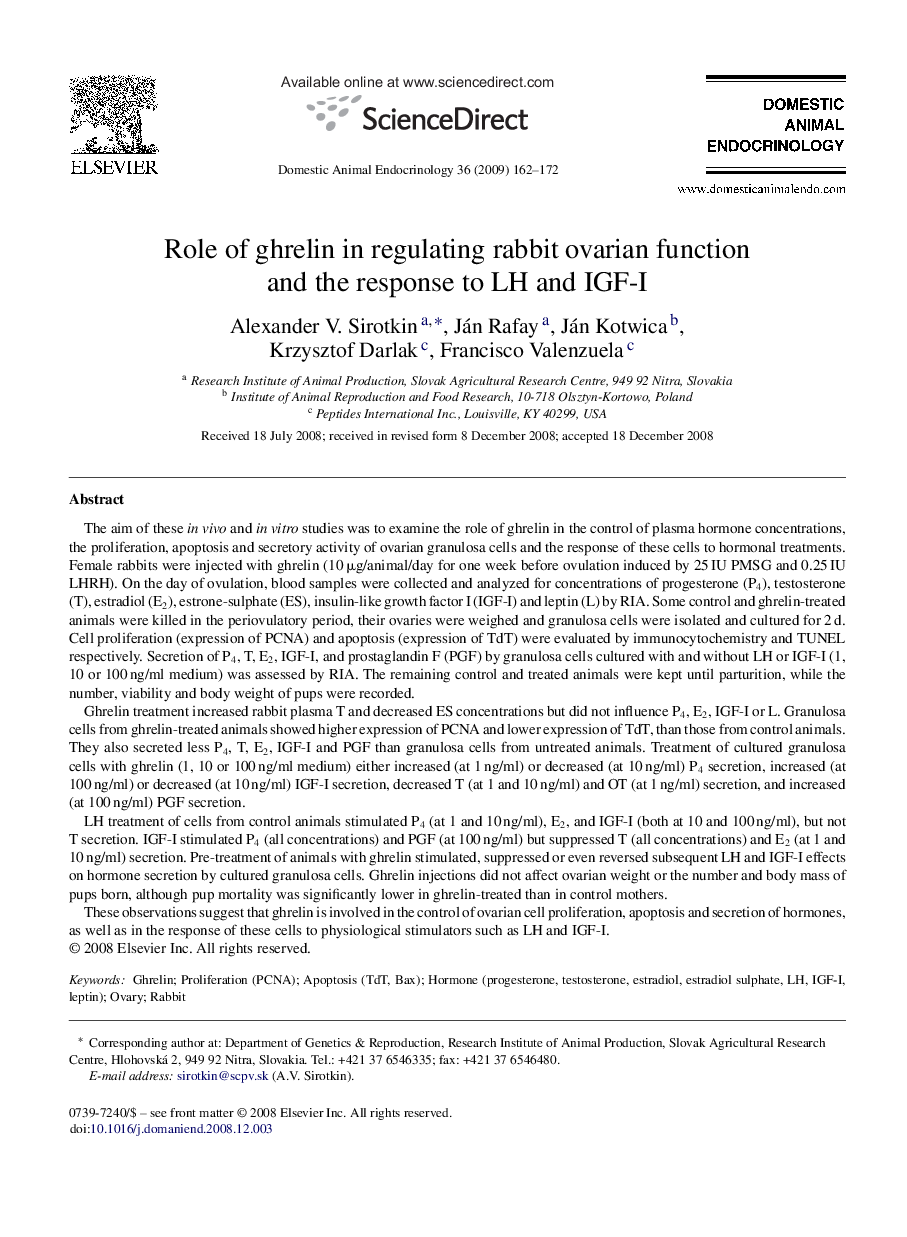| کد مقاله | کد نشریه | سال انتشار | مقاله انگلیسی | نسخه تمام متن |
|---|---|---|---|---|
| 2393911 | 1101359 | 2009 | 11 صفحه PDF | دانلود رایگان |

The aim of these in vivo and in vitro studies was to examine the role of ghrelin in the control of plasma hormone concentrations, the proliferation, apoptosis and secretory activity of ovarian granulosa cells and the response of these cells to hormonal treatments. Female rabbits were injected with ghrelin (10 μg/animal/day for one week before ovulation induced by 25 IU PMSG and 0.25 IU LHRH). On the day of ovulation, blood samples were collected and analyzed for concentrations of progesterone (P4), testosterone (T), estradiol (E2), estrone-sulphate (ES), insulin-like growth factor I (IGF-I) and leptin (L) by RIA. Some control and ghrelin-treated animals were killed in the periovulatory period, their ovaries were weighed and granulosa cells were isolated and cultured for 2 d. Cell proliferation (expression of PCNA) and apoptosis (expression of TdT) were evaluated by immunocytochemistry and TUNEL respectively. Secretion of P4, T, E2, IGF-I, and prostaglandin F (PGF) by granulosa cells cultured with and without LH or IGF-I (1, 10 or 100 ng/ml medium) was assessed by RIA. The remaining control and treated animals were kept until parturition, while the number, viability and body weight of pups were recorded.Ghrelin treatment increased rabbit plasma T and decreased ES concentrations but did not influence P4, E2, IGF-I or L. Granulosa cells from ghrelin-treated animals showed higher expression of PCNA and lower expression of TdT, than those from control animals. They also secreted less P4, T, E2, IGF-I and PGF than granulosa cells from untreated animals. Treatment of cultured granulosa cells with ghrelin (1, 10 or 100 ng/ml medium) either increased (at 1 ng/ml) or decreased (at 10 ng/ml) P4 secretion, increased (at 100 ng/ml) or decreased (at 10 ng/ml) IGF-I secretion, decreased T (at 1 and 10 ng/ml) and OT (at 1 ng/ml) secretion, and increased (at 100 ng/ml) PGF secretion.LH treatment of cells from control animals stimulated P4 (at 1 and 10 ng/ml), E2, and IGF-I (both at 10 and 100 ng/ml), but not T secretion. IGF-I stimulated P4 (all concentrations) and PGF (at 100 ng/ml) but suppressed T (all concentrations) and E2 (at 1 and 10 ng/ml) secretion. Pre-treatment of animals with ghrelin stimulated, suppressed or even reversed subsequent LH and IGF-I effects on hormone secretion by cultured granulosa cells. Ghrelin injections did not affect ovarian weight or the number and body mass of pups born, although pup mortality was significantly lower in ghrelin-treated than in control mothers.These observations suggest that ghrelin is involved in the control of ovarian cell proliferation, apoptosis and secretion of hormones, as well as in the response of these cells to physiological stimulators such as LH and IGF-I.
Journal: Domestic Animal Endocrinology - Volume 36, Issue 3, April 2009, Pages 162–172